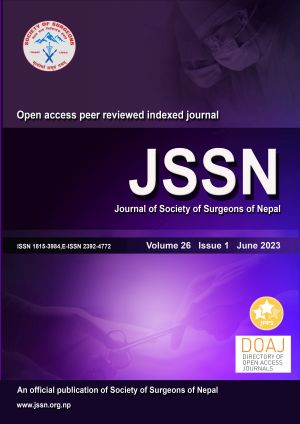Efficacy Of 18FDG-PET/CT In Predicting Response After Neoadjuvant Chemoradiation In Rectal Cancer
DOI:
https://doi.org/10.3126/jssn.v26i1.57387Keywords:
Chemoradiotherapy, PET/CT, Rectal cancer, Tumor regressionAbstract
Introduction: Neoadjuvant chemoradiation (NACRT) may result in significant response in rectal cancer. Conventional imaging may not be accurate. 18FDG-PET/CT scan has shown promising results for monitoring the response to NACRT. The aim of this study is to evaluate the role of 18FDG-PET/CT scan in predicting pathological response after NACRT in carcinoma rectum.
Methods: Thirty-two consecutive patients with locally advanced rectal cancer were enrolled. Patients underwent NACRT comprising of external beam radiotherapy and concomitant infusional 5-FU based chemotherapy. It was followed 6 weeks later by total mesorectal excision. All patients underwent FDG-PET/CT before and minimum 6 weeks after the completion of NACRT. Maximum standardized uptake (SUVmax) value was calculated. The tumor regression grade (TRG) in resected specimen was scored according to the Mandard criteria. TRG 1-2 was considered as responders and TRG 3-5, non-responders. The SUVmax within the tumor was correlated to differentiate pathological responders from non-responders.
Results: Fourteen of 30 patients were excluded due to protocol deviation. Following NACRT, 7 (50%) patients were classified as responders (TRG 1-2) and 7 (50%) non-responders (TRG 3-5). There were no significant differences in pre NACRT SUVmax between responders (12.05±2.81) and non-responders (17.65±7.20) (p=0.079). The mean post-NACRT SUVmax was significantly lower in responders than non-responders (6.4 vs 10.8; p=0.024). To compare the response using ROC curve analysis (AUC=0.83), and considering a cut-off post SUVmax as 7.0, the sensitivity was 57.14%, specificity 71.43%, positive predictive value (PPV) 66.67%, negative predictive value (NPV) 62.50%, and the overall accuracy was 64.28% to differentiate pathological responders from non-responders.
Conclusion: These preliminary results suggest that 18FDG-PET/CT could be a potentially useful tool in predicting response after NACRT in locally advanced rectal cancer. Post SUVmax of 7.0 appears to be the best predictor tumor response following NACRT.
Downloads
Downloads
Published
How to Cite
Issue
Section
License
Copyright (c) 2023 Narendra Pandit, B R Mittal, Nandita Kakkar, G R Verma

This work is licensed under a Creative Commons Attribution 4.0 International License.
This license enables reusers to distribute, remix, adapt, and build upon the material in any medium or format, so long as attribution is given to the creator. The license allows for commercial use.




